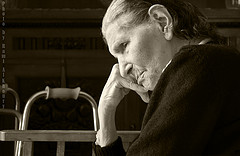 When people learn that our team serves as a law firm for elder abuse victims in San Francisco and throughout Northern California, and when they learn how incredibly common the problem is, they often ask how they can help. These people often express concern about their ability to identify elder abuse. This is an understandable concern. Like other forms of abuse, mistreatment of seniors is often hidden. Victims may be unwilling to report the problem due to fear of retribution or unable to report abuse due to physical and/or mental infirmities.
When people learn that our team serves as a law firm for elder abuse victims in San Francisco and throughout Northern California, and when they learn how incredibly common the problem is, they often ask how they can help. These people often express concern about their ability to identify elder abuse. This is an understandable concern. Like other forms of abuse, mistreatment of seniors is often hidden. Victims may be unwilling to report the problem due to fear of retribution or unable to report abuse due to physical and/or mental infirmities.
We want to provide an overview of several forms of elder abuse in order to help our concerned community members identify the problem. In order to do so, we consulted a guide provided to a specific group on individuals who are required to report elder abuse by California law. The guide, titled Reporting Elder and Dependent Adult Abuse, is given staff members at a range of California elder care facilities. It breaks elder abuse into the following categories to help these mandated reporters understand the issue:
- Physical abuse – This includes physical assault, unreasonable restraints, misuse of medications, and sexual abuse. Indicators of abuse can include bruises, broken bones, fractures, bloody/soiled clothing, appearing excessively drugged, and exhibiting intense fear. These signs do not always mean abuse exists and physical abuse can also exist where these signs are absent.
 San Francisco Injury Lawyer Blog
San Francisco Injury Lawyer Blog


 Our San Francisco and Oakland elder abuse law firm has been working for years to raise public awareness of the problem of elder abuse. We are proud of this work and believe it is essential to preventing and addressing the mistreatment of our seniors, but we know our voice is not enough on its own. Often, campaigns for socio-political change need to have a big name celebrity who helps draw the fame-crazed public’s attention to a serious and important matter. In March 2011, Mickey Rooney took on this role, talking about his first-hand experience as a
Our San Francisco and Oakland elder abuse law firm has been working for years to raise public awareness of the problem of elder abuse. We are proud of this work and believe it is essential to preventing and addressing the mistreatment of our seniors, but we know our voice is not enough on its own. Often, campaigns for socio-political change need to have a big name celebrity who helps draw the fame-crazed public’s attention to a serious and important matter. In March 2011, Mickey Rooney took on this role, talking about his first-hand experience as a  Speaking broadly, financial exploitation of seniors is the improper and/or illegal use of property, funds, or other assets of a person aged 60 years of older. In the recent article, Consumer Reports shifted attention from stranger-based scams, like fake sweepstakes and falsified calls from stranded grandchildren, to claims perpetrated by people the victim trusted such as family, neighbors, and employees. A Ventura County judge called these crimes “the ultimate betrayal,” noting she sees around forty cases involving such abuse each month in courtroom. Financial exploitation is the most reported form of elder abuse with cases running a huge gamut from misappropriation of a Social Security check to draining a senior’s life savings.
Speaking broadly, financial exploitation of seniors is the improper and/or illegal use of property, funds, or other assets of a person aged 60 years of older. In the recent article, Consumer Reports shifted attention from stranger-based scams, like fake sweepstakes and falsified calls from stranded grandchildren, to claims perpetrated by people the victim trusted such as family, neighbors, and employees. A Ventura County judge called these crimes “the ultimate betrayal,” noting she sees around forty cases involving such abuse each month in courtroom. Financial exploitation is the most reported form of elder abuse with cases running a huge gamut from misappropriation of a Social Security check to draining a senior’s life savings.  Bloomberg’s research delved deeper into a November report in which federal health care inspectors concluded the nursing home industry overbills Medicare to the tune of $1.5 billion (yes, with a “b”) annually for treatments patients either don’t need or never actually receive. The further study focused on profit motives, noting that investigators deemed thirty percent of reviewed studied claims from for-profit facilities improper, compared to a significantly smaller (though still too high) twelve percent from non-profit homes. At least six other studies undertaken by government and academic bodies in the past three years reached similar conclusions, finding that the rise in the number of for-profit providers is leading to waste and fraud. Likewise, this profit-driven culture is fueling patient harm.
Bloomberg’s research delved deeper into a November report in which federal health care inspectors concluded the nursing home industry overbills Medicare to the tune of $1.5 billion (yes, with a “b”) annually for treatments patients either don’t need or never actually receive. The further study focused on profit motives, noting that investigators deemed thirty percent of reviewed studied claims from for-profit facilities improper, compared to a significantly smaller (though still too high) twelve percent from non-profit homes. At least six other studies undertaken by government and academic bodies in the past three years reached similar conclusions, finding that the rise in the number of for-profit providers is leading to waste and fraud. Likewise, this profit-driven culture is fueling patient harm.